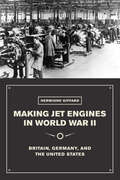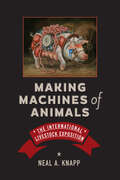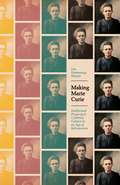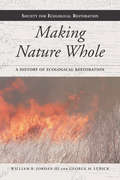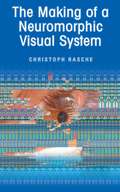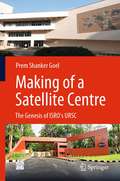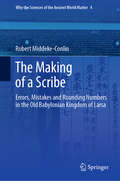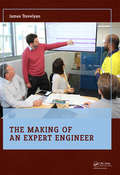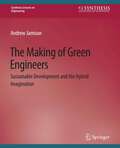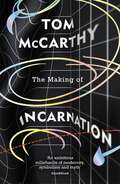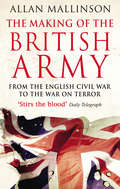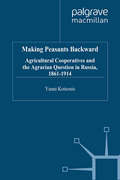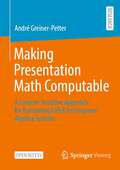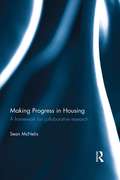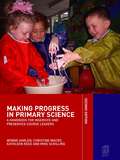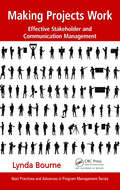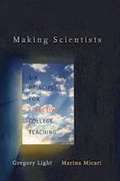- Table View
- List View
Making Jet Engines in World War II: Britain, Germany, and the United States
by Hermione GiffardOur stories of industrial innovation tend to focus on individual initiative and breakthroughs. With Making Jet Engines in World War II, Hermione Giffard uses the case of the development of jet engines to offer a different way of understanding technological innovation, revealing the complicated mix of factors that go into any decision to pursue an innovative, and therefore risky technology. Giffard compares the approaches of Britain, Germany, and the United States. Each approached jet engines in different ways because of its own war aims and industrial expertise. Germany, which produced more jet engines than the others, did so largely as replacements for more expensive piston engines. Britain, on the other hand, produced relatively few engines—but, by shifting emphasis to design rather than production, found itself at war's end holding an unrivaled range of designs. The US emphasis on development, meanwhile, built an institutional basis for postwar production. Taken together, Giffard's work makes a powerful case for a more nuanced understanding of technological innovation, one that takes into account the influence of the many organizational factors that play a part in the journey from idea to finished product.
Making Machines of Animals: The International Livestock Exposition (Animals, History, Culture)
by Neal A. KnappHow the Chicago International Livestock Exposition leveraged the eugenics movement to transform animals into machines and industrialize American agriculture.In 1900, the Chicago International Livestock Exposition became the epicenter of agricultural reform that focused on reinventing animals' bodies to fit a modern, industrial design. Chicago meatpackers partnered with land-grant university professors to create the International—a spectacle on the scale of a world's fair—with the intention of setting the standard for animal quality and, in doing so, transformed American agriculture.In Making Machines of Animals, Neal A. Knapp explains the motivations of both the meatpackers and the professors, describing how they deployed the International to redefine animality itself. Both professors and packers hoped to replace so-called scrub livestock with "improved" animals and created a new taxonomy of animal quality based on the burgeoning eugenics movement. The International created novel definitions of animal superiority and codified new norms, resulting in a dramatic shift in animal weight, body size, and market age. These changes transformed the animals from multipurpose to single-purpose products. These standardized animals and their dependence on off-the-farm inputs and exchanges limited farmer choices regarding husbandry and marketing, ultimately undermining any goals for balanced farming or the maintenance and regeneration of soil fertility.Drawing on land-grant university research and publications, meatpacker records and propaganda, and newspaper and agricultural journal articles, Knapp critiques the supposed market-oriented, efficiency-driven industrial reforms proffered by the International, which were underpinned by irrational, racist ideologies. The livestock reform movement not only resulted in cruel and violent outcomes for animals but also led to twentieth-century crops and animal husbandry that were rife with inefficiencies and agricultural vulnerabilities.
Making Machines of Animals: The International Livestock Exposition (Animals, History, Culture)
by Neal A. KnappHow the Chicago International Livestock Exposition leveraged the eugenics movement to transform animals into machines and industrialize American agriculture.In 1900, the Chicago International Livestock Exposition became the epicenter of agricultural reform that focused on reinventing animals' bodies to fit a modern, industrial design. Chicago meatpackers partnered with land-grant university professors to create the International—a spectacle on the scale of a world's fair—with the intention of setting the standard for animal quality and, in doing so, transformed American agriculture.In Making Machines of Animals, Neal A. Knapp explains the motivations of both the meatpackers and the professors, describing how they deployed the International to redefine animality itself. Both professors and packers hoped to replace so-called scrub livestock with "improved" animals and created a new taxonomy of animal quality based on the burgeoning eugenics movement. The International created novel definitions of animal superiority and codified new norms, resulting in a dramatic shift in animal weight, body size, and market age. These changes transformed the animals from multipurpose to single-purpose products. These standardized animals and their dependence on off-the-farm inputs and exchanges limited farmer choices regarding husbandry and marketing, ultimately undermining any goals for balanced farming or the maintenance and regeneration of soil fertility.Drawing on land-grant university research and publications, meatpacker records and propaganda, and newspaper and agricultural journal articles, Knapp critiques the supposed market-oriented, efficiency-driven industrial reforms proffered by the International, which were underpinned by irrational, racist ideologies. The livestock reform movement not only resulted in cruel and violent outcomes for animals but also led to twentieth-century crops and animal husbandry that were rife with inefficiencies and agricultural vulnerabilities.
Making Marie Curie: Intellectual Property and Celebrity Culture in an Age of Information (science.culture)
by Eva Hemmungs WirténIn many ways, Marie Curie represents modern science. Her considerable lifetime achievements—the first woman to be awarded a Nobel Prize, the only woman to be awarded the Prize in two fields, and the only person to be awarded Nobel Prizes in multiple sciences—are studied by schoolchildren across the world. When, in 2009, the New Scientist carried out a poll for the “Most Inspirational Female Scientist of All Time,” the result was a foregone conclusion: Marie Curie trounced her closest runner-up, Rosalind Franklin, winning double the number of Franklin’s votes. She is a role model to women embarking on a career in science, the pride of two nations—Poland and France—and, not least of all, a European Union brand for excellence in science. Making Marie Curie explores what went into the creation of this icon of science. It is not a traditional biography, or one that attempts to uncover the “real” Marie Curie. Rather, Eva Hemmungs Wirtén, by tracing a career that spans two centuries and a world war, provides an innovative and historically grounded account of how modern science emerges in tandem with celebrity culture under the influence of intellectual property in a dawning age of information. She explores the emergence of the Curie persona, the information culture of the period that shaped its development, and the strategies Curie used to manage and exploit her intellectual property. How did one create and maintain for oneself the persona of scientist at the beginning of the twentieth century? What special conditions bore upon scientific women, and on married women in particular? How was French identity claimed, established, and subverted? How, and with what consequences, was a scientific reputation secured? In its exploration of these questions and many more, Making Marie Curie provides a composite picture not only of the making of Marie Curie, but the making of modern science itself.
Making Marie Curie: Intellectual Property and Celebrity Culture in an Age of Information (science.culture)
by Eva Hemmungs WirténIn many ways, Marie Curie represents modern science. Her considerable lifetime achievements—the first woman to be awarded a Nobel Prize, the only woman to be awarded the Prize in two fields, and the only person to be awarded Nobel Prizes in multiple sciences—are studied by schoolchildren across the world. When, in 2009, the New Scientist carried out a poll for the “Most Inspirational Female Scientist of All Time,” the result was a foregone conclusion: Marie Curie trounced her closest runner-up, Rosalind Franklin, winning double the number of Franklin’s votes. She is a role model to women embarking on a career in science, the pride of two nations—Poland and France—and, not least of all, a European Union brand for excellence in science. Making Marie Curie explores what went into the creation of this icon of science. It is not a traditional biography, or one that attempts to uncover the “real” Marie Curie. Rather, Eva Hemmungs Wirtén, by tracing a career that spans two centuries and a world war, provides an innovative and historically grounded account of how modern science emerges in tandem with celebrity culture under the influence of intellectual property in a dawning age of information. She explores the emergence of the Curie persona, the information culture of the period that shaped its development, and the strategies Curie used to manage and exploit her intellectual property. How did one create and maintain for oneself the persona of scientist at the beginning of the twentieth century? What special conditions bore upon scientific women, and on married women in particular? How was French identity claimed, established, and subverted? How, and with what consequences, was a scientific reputation secured? In its exploration of these questions and many more, Making Marie Curie provides a composite picture not only of the making of Marie Curie, but the making of modern science itself.
Making Marie Curie: Intellectual Property and Celebrity Culture in an Age of Information (science.culture)
by Eva Hemmungs WirténIn many ways, Marie Curie represents modern science. Her considerable lifetime achievements—the first woman to be awarded a Nobel Prize, the only woman to be awarded the Prize in two fields, and the only person to be awarded Nobel Prizes in multiple sciences—are studied by schoolchildren across the world. When, in 2009, the New Scientist carried out a poll for the “Most Inspirational Female Scientist of All Time,” the result was a foregone conclusion: Marie Curie trounced her closest runner-up, Rosalind Franklin, winning double the number of Franklin’s votes. She is a role model to women embarking on a career in science, the pride of two nations—Poland and France—and, not least of all, a European Union brand for excellence in science. Making Marie Curie explores what went into the creation of this icon of science. It is not a traditional biography, or one that attempts to uncover the “real” Marie Curie. Rather, Eva Hemmungs Wirtén, by tracing a career that spans two centuries and a world war, provides an innovative and historically grounded account of how modern science emerges in tandem with celebrity culture under the influence of intellectual property in a dawning age of information. She explores the emergence of the Curie persona, the information culture of the period that shaped its development, and the strategies Curie used to manage and exploit her intellectual property. How did one create and maintain for oneself the persona of scientist at the beginning of the twentieth century? What special conditions bore upon scientific women, and on married women in particular? How was French identity claimed, established, and subverted? How, and with what consequences, was a scientific reputation secured? In its exploration of these questions and many more, Making Marie Curie provides a composite picture not only of the making of Marie Curie, but the making of modern science itself.
Making Marie Curie: Intellectual Property and Celebrity Culture in an Age of Information (science.culture)
by Eva Hemmungs WirténIn many ways, Marie Curie represents modern science. Her considerable lifetime achievements—the first woman to be awarded a Nobel Prize, the only woman to be awarded the Prize in two fields, and the only person to be awarded Nobel Prizes in multiple sciences—are studied by schoolchildren across the world. When, in 2009, the New Scientist carried out a poll for the “Most Inspirational Female Scientist of All Time,” the result was a foregone conclusion: Marie Curie trounced her closest runner-up, Rosalind Franklin, winning double the number of Franklin’s votes. She is a role model to women embarking on a career in science, the pride of two nations—Poland and France—and, not least of all, a European Union brand for excellence in science. Making Marie Curie explores what went into the creation of this icon of science. It is not a traditional biography, or one that attempts to uncover the “real” Marie Curie. Rather, Eva Hemmungs Wirtén, by tracing a career that spans two centuries and a world war, provides an innovative and historically grounded account of how modern science emerges in tandem with celebrity culture under the influence of intellectual property in a dawning age of information. She explores the emergence of the Curie persona, the information culture of the period that shaped its development, and the strategies Curie used to manage and exploit her intellectual property. How did one create and maintain for oneself the persona of scientist at the beginning of the twentieth century? What special conditions bore upon scientific women, and on married women in particular? How was French identity claimed, established, and subverted? How, and with what consequences, was a scientific reputation secured? In its exploration of these questions and many more, Making Marie Curie provides a composite picture not only of the making of Marie Curie, but the making of modern science itself.
Making Marie Curie: Intellectual Property and Celebrity Culture in an Age of Information (science.culture)
by Eva Hemmungs WirténIn many ways, Marie Curie represents modern science. Her considerable lifetime achievements—the first woman to be awarded a Nobel Prize, the only woman to be awarded the Prize in two fields, and the only person to be awarded Nobel Prizes in multiple sciences—are studied by schoolchildren across the world. When, in 2009, the New Scientist carried out a poll for the “Most Inspirational Female Scientist of All Time,” the result was a foregone conclusion: Marie Curie trounced her closest runner-up, Rosalind Franklin, winning double the number of Franklin’s votes. She is a role model to women embarking on a career in science, the pride of two nations—Poland and France—and, not least of all, a European Union brand for excellence in science. Making Marie Curie explores what went into the creation of this icon of science. It is not a traditional biography, or one that attempts to uncover the “real” Marie Curie. Rather, Eva Hemmungs Wirtén, by tracing a career that spans two centuries and a world war, provides an innovative and historically grounded account of how modern science emerges in tandem with celebrity culture under the influence of intellectual property in a dawning age of information. She explores the emergence of the Curie persona, the information culture of the period that shaped its development, and the strategies Curie used to manage and exploit her intellectual property. How did one create and maintain for oneself the persona of scientist at the beginning of the twentieth century? What special conditions bore upon scientific women, and on married women in particular? How was French identity claimed, established, and subverted? How, and with what consequences, was a scientific reputation secured? In its exploration of these questions and many more, Making Marie Curie provides a composite picture not only of the making of Marie Curie, but the making of modern science itself.
Making Marie Curie: Intellectual Property and Celebrity Culture in an Age of Information (science.culture)
by Eva Hemmungs WirténIn many ways, Marie Curie represents modern science. Her considerable lifetime achievements—the first woman to be awarded a Nobel Prize, the only woman to be awarded the Prize in two fields, and the only person to be awarded Nobel Prizes in multiple sciences—are studied by schoolchildren across the world. When, in 2009, the New Scientist carried out a poll for the “Most Inspirational Female Scientist of All Time,” the result was a foregone conclusion: Marie Curie trounced her closest runner-up, Rosalind Franklin, winning double the number of Franklin’s votes. She is a role model to women embarking on a career in science, the pride of two nations—Poland and France—and, not least of all, a European Union brand for excellence in science. Making Marie Curie explores what went into the creation of this icon of science. It is not a traditional biography, or one that attempts to uncover the “real” Marie Curie. Rather, Eva Hemmungs Wirtén, by tracing a career that spans two centuries and a world war, provides an innovative and historically grounded account of how modern science emerges in tandem with celebrity culture under the influence of intellectual property in a dawning age of information. She explores the emergence of the Curie persona, the information culture of the period that shaped its development, and the strategies Curie used to manage and exploit her intellectual property. How did one create and maintain for oneself the persona of scientist at the beginning of the twentieth century? What special conditions bore upon scientific women, and on married women in particular? How was French identity claimed, established, and subverted? How, and with what consequences, was a scientific reputation secured? In its exploration of these questions and many more, Making Marie Curie provides a composite picture not only of the making of Marie Curie, but the making of modern science itself.
Making Nature Whole: A History of Ecological Restoration (The Science and Practice of Ecological Restoration)
by William R. Jordan III George M. LubickMaking Nature Whole is a seminal volume that presents an in-depth history of the field of ecological restoration as it has developed in the United States over the last three decades. The authors draw from both published and unpublished sources, including archival materials and oral histories from early practitioners, to explore the development of the field and its importance to environmental management as well as to the larger environmental movement and our understanding of the world.Making Nature Whole is a landmark contribution, providing context and history regarding a distinctive form of land management and giving readers a fascinating overview of the development of the field. It is essential reading for anyone interested in understanding where ecological restoration came from or where it might be going.
Making of a Satellite Centre: The Genesis of ISRO's URSC
by Prem Shanker GoelThis book tells the story of the evolution of the Satellite Center which started from a small Satellite Systems Division in 1967 with a handful of engineers to a vibrant R&D center which is playing the lead role in the Indian Satellite Program. India's space program is unique as it is driven by societal applications. The Indian Space Research Organisation (ISRO) has centers dedicated to various space applications. The ISRO Satellite Centre, now known as the UR Rao Satellite Centre (URSC), has evolved as lead center for Satellite Technology over five decades and has developed state-of-the-art satellites for applications such as remote sensing, satellite communication and space science. Through the story of URSC, the book describes the challenges of putting together new research and development centers and programs and conveys the importance of leadership and project management skills required to undertake such a task. This book is of interest to researchers, professionals, and administrators involved in the development of new R&D facilities and also to space scientists and space enthusiasts across the world.
The Making of a Scribe: Errors, Mistakes and Rounding Numbers in the Old Babylonian Kingdom of Larsa (Why the Sciences of the Ancient World Matter #4)
by Robert Middeke-ConlinThis book presents a novel methodology to study economic texts. The author investigates discrepancies in these writings by focusing on errors, mistakes, and rounding numbers. In particular, he looks at the acquisition, use, and development of practical mathematics in an ancient society: The Old Babylonian kingdom of Larsa (beginning of the second millennium BCE Southern Iraq). In so doing, coverage bridges a gap between the sciences and humanities. Through this work, the reader will gain insight into discrepancies encountered in economic texts in general and rounding numbers in particular. They will learn a new framework to explain error as a form of economic practice. Researchers and students will also become aware of the numerical and metrological basis for calculation in these writings and how the scribes themselves conceptualized value. This work fills a void in Assyriological studies. It provides a methodology to explore, understand, and exploit statistical data. The anlaysis also fills a void in the history of mathematics by presenting historians of mathematics a method to study practical texts. In addition, the author shows the importance mathematics has as a tool for ancient practitioners to cope with complex economic processes. This serves as a useful case study for modern policy makers into the importance of education in any economy.
The Making of an Expert Engineer
by James TrevelyanThis book sets out the principles of engineering practice, knowledge that has come to light through more than a decade of research by the author and his students studying engineers at work. Until now, this knowledge has been almost entirely unwritten, passed on invisibly from one generation of engineers to the next, what engineers refer to asexpe
The Making of Green Engineers: Sustainable Development and the Hybrid Imagination (Synthesis Lectures on Engineering)
by Andrew JamisonThis book discusses the ways in which engineering educators are responding to the challenges that confront their profession. On the one hand, there is an overarching sustainability challenge: the need for engineers to relate to the problems brought to light in the debates about environmental protection, resource depletion, and climate change. There are also a range of societal challenges that are due to the permeation of science and technology into ever more areas of our societies and everyday lives, and finally, there are the intrinsic scientific and technological challenges stemming from the emergence of new fields of "technosciences" that mix science and technology in new combinations. In the book, the author discusses and exemplifies three contending response strategies on the part of engineers and engineering educators: a commercial strategy that links scientists and engineers into networks or systems of innovation; an academic strategy that reasserts the traditional values of science and engineering; and an integrative strategy that aims to combine scientific knowledge and engineering skills with cultural understanding and social responsibility by fostering what the author terms a "hybrid imagination." Professor Jamison combines scholarly analysis with personal reflections drawing on over forty years of experience as a humanist teaching science and engineering students about the broader social, political and cultural contexts of their fields. The book has been written as part of the Program of Research on Opportunities and Challenges in Engineering Education in Denmark (PROCEED), funded by the Danish Strategic Research Council, for which Professor Jamison has served as coordinator.
The Making of Incarnation: FROM THE TWICE BOOKER SHORLISTED AUTHOR OF C AND SATIN ISLAND
by Tom McCarthyBodies in motion. Birds, bees and bobsleighs. What is the force that moves the sun and other stars? Where's our fucking airplane? What's inside Box 808, and why does everybody want it? Deep within the archives of time-and-motion pioneer Lillian Gilbreth lies a secret. Famous for producing solid light-tracks that captured the path of workers' movements, Gilbreth helped birth the era of mass observation and big data. Did she also, as her broken correspondence with a young Soviet physicist suggests, discover in her final days a 'perfect' movement, one that would 'change everything'? An international hunt begins for the one box missing from her records, and we follow contemporary motion-capture consultant Mark Phocan across geo-political fault lines and experimental zones: places where the frontiers of potential - to cure, kill, understand or entertain - are constantly tested and refined. And all the while, work is underway on the blockbuster film Incarnation, an epic space tragedy. Audacious and mesmeric, The Making of Incarnation weaves a set of stories one inside the other, rings within rings, a perpetual-motion machine. Tom McCarthy peers through the screen, or veil, of technological modernity to reveal the underlying historical and symbolic structures of human experience.
The Making Of The British Army: From The English Civil War To The War On Terror
by Allan MallinsonEdgehill, 1642: Surveying the disastrous scene in the aftermath of the first battle of the English Civil War, Oliver Cromwell realizes that war can no longer be made in the old, feudal way: there has to be system and discipline, and therefore - eventually - a standing professional army.From the 'New Model Army' of Cromwell's distant vision, former soldier Allan Mallinson shows us the people and events that have shaped the army we know today. How Marlborough's momentous victory at Blenheim is linked to Wellington's at Waterloo; how the desperate fight at Rorke's Drift in 1879 underpinned the heroism of the airborne forces at Arnhem in 1944; and why Montgomery's momentous victory at El Alamein mattered long after the Second World War was over. From the Army's origins at the battle of Edgehill to our current conflict in Afghanistan, this is history at its most relevant - and most dramatic.
Making Peasants Backward: Agricultural Cooperatives and the Agrarian Question in Russia, 1861–1914
by Y. KotsonisIn this first monograph on the Russian cooperative movement before 1914, economic and social change is considered alongside Russian political culture. Looking at such historical actors as Sergei Witte, Piotr Stolypin, and Alexander Chaianov, and by tapping into several newly opened Russian local and state archives on peasant practice in the movement, Kotsonis suggests how cooperatives reflected a pan-European dilemma over whether and to what extent populations could participate in their own transformation.
Making Presentation Math Computable: A Context-Sensitive Approach for Translating LaTeX to Computer Algebra Systems
by André Greiner-PetterThis Open-Access-book addresses the issue of translating mathematical expressions from LaTeX to the syntax of Computer Algebra Systems (CAS). Over the past decades, especially in the domain of Sciences, Technology, Engineering, and Mathematics (STEM), LaTeX has become the de-facto standard to typeset mathematical formulae in publications. Since scientists are generally required to publish their work, LaTeX has become an integral part of today's publishing workflow. On the other hand, modern research increasingly relies on CAS to simplify, manipulate, compute, and visualize mathematics. However, existing LaTeX import functions in CAS are limited to simple arithmetic expressions and are, therefore, insufficient for most use cases. Consequently, the workflow of experimenting and publishing in the Sciences often includes time-consuming and error-prone manual conversions between presentational LaTeX and computational CAS formats. To address the lack of a reliable and comprehensive translation tool between LaTeX and CAS, this thesis makes the following three contributions. First, it provides an approach to semantically enhance LaTeX expressions with sufficient semantic information for translations into CAS syntaxes. Second, it demonstrates the first context-aware LaTeX to CAS translation framework LaCASt. Third, the thesis provides a novel approach to evaluate the performance for LaTeX to CAS translations on large-scaled datasets with an automatic verification of equations in digital mathematical libraries.This is an open access book.
Making Progress in Housing: A Framework for Collaborative Research (Routledge Housing Research Series)
by Sean McNelisThis book presents a new approach to housing research, one that is relevant to all the social sciences. Housing research is diverse and operates across many disciplines, approaches and methods making collaboration difficult. This book outlines a methodological framework that enables researchers from many different fields to collaborate in solving complex and seemingly intractable housing problems. It shows how we can make progress in housing research and deliver better housing outcomes through an integrated approach. Drawing on the work of renowned Canadian methodologist, philosopher, theologian and economist, Bernard Lonergan (1904–1984), McNelis outlines a framework for collaborative research: Functional Collaboration. This new form of collaboration divides up the work of housing research into functional specialties. These distinguish eight inter-related questions that arise in the process of moving from the current housing situation through to providing practical advice to decision-makers. To answer each question a different method is required. Making progress in housing is the result of finding new answers to this complete set of eight inter-related questions. This approach to collaboration opens up a new discourse on method in housing and social research as well as new debates on progress and the nature of science.
Making Progress in Housing: A Framework for Collaborative Research (Routledge Housing Research Series)
by Sean McNelisThis book presents a new approach to housing research, one that is relevant to all the social sciences. Housing research is diverse and operates across many disciplines, approaches and methods making collaboration difficult. This book outlines a methodological framework that enables researchers from many different fields to collaborate in solving complex and seemingly intractable housing problems. It shows how we can make progress in housing research and deliver better housing outcomes through an integrated approach. Drawing on the work of renowned Canadian methodologist, philosopher, theologian and economist, Bernard Lonergan (1904–1984), McNelis outlines a framework for collaborative research: Functional Collaboration. This new form of collaboration divides up the work of housing research into functional specialties. These distinguish eight inter-related questions that arise in the process of moving from the current housing situation through to providing practical advice to decision-makers. To answer each question a different method is required. Making progress in housing is the result of finding new answers to this complete set of eight inter-related questions. This approach to collaboration opens up a new discourse on method in housing and social research as well as new debates on progress and the nature of science.
Making Progress in Primary Science: A Study Book for Teachers and Student Teachers
by Wynne Harlen Christine Macro Kathleen Reed Mike SchillingThis new and extensively revised edition of Progress in Primary Science is intended for all those involved in training teachers of primary school science, both preservice and on INSET courses. Its flexible modular structure enables course leaders to tailor their course to participants' needs. Each module can be studied individually or as part of an extended programme and contains notes for facilitators, photocopiable workshop materials, activities for practitioners and suggestions for further reading. Throughout the book the focus is on the learning of science as an investigative process through which pupils develop an understanding of ideas. This is supported by modules on different aspects of teaching and learning in science, including: building on children's own ideas how to ask and answer questions managing practical work in the classroom science for very young children effective assessment, self-assessment and feedback cross-curricular links ICT and science science outside the classroom. The companion study book currently available can be used by those participating on these courses. It follows the same modular structure and contains the same information as this book, and makes planning and delivering the course easier and less time consuming for the course leader.
Making Progress in Primary Science: A Study Book for Teachers and Student Teachers
by Wynne Harlen Christine Macro Kathleen Reed Mike SchillingThis new and extensively revised edition of Progress in Primary Science is intended for all those involved in training teachers of primary school science, both preservice and on INSET courses. Its flexible modular structure enables course leaders to tailor their course to participants' needs. Each module can be studied individually or as part of an extended programme and contains notes for facilitators, photocopiable workshop materials, activities for practitioners and suggestions for further reading. Throughout the book the focus is on the learning of science as an investigative process through which pupils develop an understanding of ideas. This is supported by modules on different aspects of teaching and learning in science, including: building on children's own ideas how to ask and answer questions managing practical work in the classroom science for very young children effective assessment, self-assessment and feedback cross-curricular links ICT and science science outside the classroom. The companion study book currently available can be used by those participating on these courses. It follows the same modular structure and contains the same information as this book, and makes planning and delivering the course easier and less time consuming for the course leader.
Making Projects Work: Effective Stakeholder and Communication Management
by Lynda BourneProjects are performed by people for people, with the key determinants of success being the relationships between project teams and project stakeholders. This web of relationships will either enable or obstruct the flow of information between people and, as a consequence, will largely determine project success or failure.Making Projects Work: Effec
Making Scientists: Six Principles For Effective College Teaching
by Gregory LightGregory Light and Marina Micari reject the view that science, technology, engineering, and mathematics are elite disciplines restricted to a small number with innate talent. Rich in concrete advice, Making Scientists offers a new paradigm of how scientific subjects can be taught at the college level to underrepresented groups.
